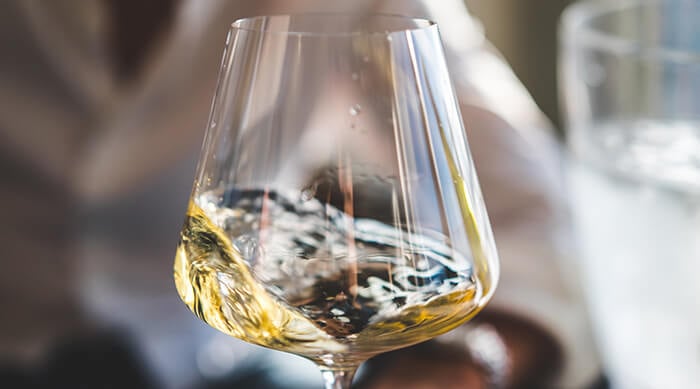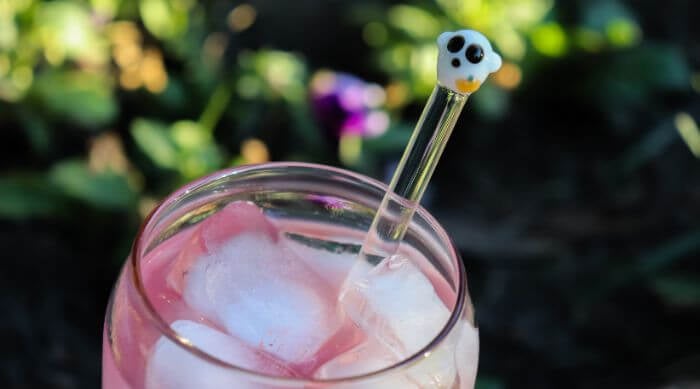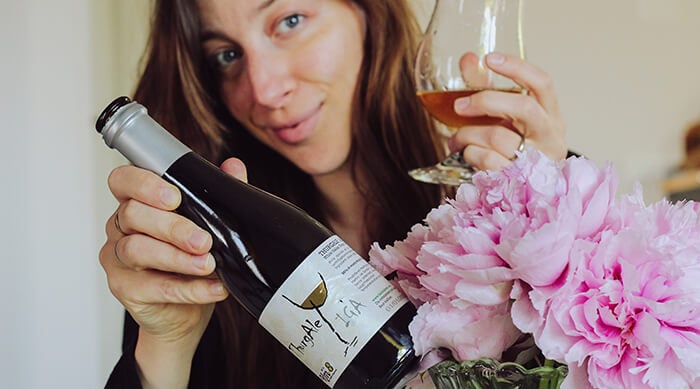Are you curious about the calorie content of your favorite types of wine? Whether you're a wine enthusiast, sober-curious, or simply looking to make mindful choices, understanding the calorie differences can help you enjoy your wine while maintaining a balanced lifestyle.
There is a formula for calculating the exact number of calories in a glass of your favorite brand of wine.
Formula for calculating calories in wine: Alcohol by volume (ABV) x ounces x 1.8 = total calories
Keep this formula handy, as it’s rare to see any nutrition facts on a wine label.
Let’s take a look at the calories in wine and how to indulge in a health-conscious way.
What are the calories in a 5 oz glass of wine? On average, a standard 5 oz glass of wine contains 123 calories. Larger pours contain more calories, so to track exact calories, you’ll need to measure your pours closely.
How many calories are in a 750ml bottle of wine? A 750ml bottle of wine contains about 600-625 calories. The overall calorie content in your glass of wine depends on the alcohol content and type of wine you are enjoying.
Table of Contents
Calories in Different Types of Wine
Where Do Wine Calories Come From?
What Is the Nutritional Value of Wine?
Calories in Different Types of Wine
The calorie count in wine depends on the type of wine and its alcohol content. Wine types are usually categorized into red wines, white wines, and pink wines called rosé.
Below, we've compiled a list of popular wine varieties and their calorie counts per 5 oz glass & 750mL bottle from lowest to highest.
Calories in wine (per 5 oz glass):
- Champagne/Sparkling Wine (White): 96 calories (19.2 calories per ounce)
- Sauvignon Blanc (White): 122 calories (24.4 calories per ounce)
- Pinot Grigio (White): 122 calories (24.4 calories per ounce)
- Merlot (Red): 122 calories (24.4 calories per ounce)
- Cabernet Sauvignon (Red): 122 calories (24.4 calories per ounce)
- Shiraz/Syrah (Red): 122 calories (24.4 calories per ounce)
- Chardonnay (White): 123 calories (24.6 calories per ounce)
- Rosé (Pink): 125 calories (25 calories per ounce)
- Riesling (White): 128 calories (25.6 calories per ounce)
- Zinfandel (Red): 129 calories (25.8 calories per ounce)
Calories in wine (per 750ml bottle of wine):
- White Wine: 600 calories per bottle
- Red Wine: 610 calories per bottle
- Rosé Wine: 625 calories per bottle
These calorie counts are approximate and can vary depending on the specific wine and its alcohol content.
FAQs
Do all wines have the same amount of calories?
No, all wines do not have the same amount of calories. White wines have slightly fewer calories, while sweeter white wines typically contain more calories. Wines with a low alcohol content (or none at all) also contain fewer calories, on average, than standard wines.
Even within specific varietals, calories in wine may vary. A California Malbec from one vineyard might contain a slightly different number of calories from one bottle or glass to the next.
How many calories are in an 8 oz glass of white wine?
There are about 194 calories in an 8 oz glass of white wine. A glass of red wine will have slightly more calories on average than white wine. Keep in mind that the CDC calculates a standard glass of wine as 5 oz.
How many calories are in a bottle of red wine?
The number of calories in a bottle of red wine is 530-660 calories at an average ABV (12-14% for wine). Dry red wine contains fewer calories than sweeter reds, so keep this in mind when calculating the caloric value of your bottle.
Is it OK to drink a bottle of wine a day?
No, it is not advisable to drink a bottle of wine (750mL) every day due to associated health risks and the potential for alcohol dependency. The USDA recommends drinking no more than one standard drink per day for women and no more than two standard drinks per day for men.
What type of wine is highest in calories?
Wines with high alcohol content and residual sugar, such as dessert wines like Doux, and fortified wines like Port and sherry, typically have the highest calorie content.
A 5-ounce serving of dessert wine can contain around 230 calories, while fortified wines can range from 150-200 calories.
Read Next: Red vs. White Wine: Similarities & Differences
What type of wine is lowest in calories?
Light and dry wines, particularly white wines like vinho verde, prosecco, and other Brut sparkling wines, are often the lowest in calories. A 5-ounce glass of vinho verde contains around 88 calories.
If you’re looking to cut back on your alcohol consumption while still enjoying a Sonoma-approved white wine, an 8 oz glass of Surely’s non-alcoholic sparkling white wine is only 40 calories!
Where Do Wine Calories Come From?
The calorie content in wine primarily comes from alcohol calories (ethenol) and residual sugars. Through the winemaking process, carbohydrates, the natural sugars from the grapes, are converted into alcohol.
The alcohol content, usually expressed as ABV (alcohol by volume), is a significant factor because alcohol has 7 calories per gram. The residual sugar left over after the fermentation process contributes to calorie count, adding 4 calories per gram.
Even with the lowest calorie options, most wine contains sugar. The sweeter the wine, the higher the sugar content.
A sweet dessert wine or sweet wines like riesling will pack a higher sugar punch than a pinot grigio. Dry white wines like sauvignon blanc are lower-carb, with only about 2 grams of carbs in a 5 oz serving size.
The calories in wine are considered empty calories. So, while wine isn’t exactly a “high-calorie” drink, the calories from alcohol that you consume don’t provide nutritional value from essential vitamins and minerals.
High-quality non-alcoholic wine often has the fewest calories due to the absence of alcohol.
What Is the Nutritional Value of Wine?
You won’t find nutritional information with grams of carbohydrates and proteins on most bottles of wine, so we’ve provided the averages here.
The nutritional value of a single 5-ounce glass of red wine consists of:
- Calories: 125
- Carbs: 4 grams
- Sugars: 1 gram
- Fat: 0 grams
- Protein: 0.1 grams
- Sodium: 6 milligrams (<1% RDI)
- Manganese: 0.2 milligrams (10% RDI)
- Potassium: 170 milligrams (5% RDI)
Here is the average nutritional value of an entire bottle of red wine:
- Calories: 625
- Carbs: 20 grams
- Sugars: 5 gram
- Fat: 0 grams
- Protein: 0.5 grams
- Sodium: 30 milligrams (1% RDI)
- Manganese: 1 milligram (50% RDI)
- Potassium: 850 milligrams (25% RDI)
If you’re looking to limit both sugars and carbs, that can be hard to do while still drinking wine.
Calories in Wine vs. Beer
- Beer: 103-200 calories per 12-ounce serving
- Wine: 100-150 calories per 5-ounce serving
When comparing wine to beer, a standard 5-ounce glass of wine typically has more calories, ranging from 100-150 calories depending on the type of wine. In comparison, a 12-ounce serving of beer generally contains 103-200 calories.
This is very dependent on the type of beer. Dark beers have more calories than light beers, and beers with a higher alcohol content will also have higher calories.
Both of these options tend to be much lower in sugar than alcoholic drinks mixed with soda. One can of soda contains an average of 39 grams of sugar (that’s 154 calories), plus the alcohol that is added to the drink.
Low-Calorie Wine Brands
Many wine producers recognize the growing demand for lower-calorie options and have responded by creating specific low-calorie wine brands.
Here are some well-known low-calorie wine options:
- Surely Wines: Our wines are low in sugar from the fermentation process and de-alcoholized. Removing the alcohol takes away all those empty calories, leaving you with a yummy wine to sip. A 15-minute walk is enough to burn the calories from even our highest-calorie wine.
- Cense Wines: Developed in collaboration with Weight Watchers, Cense Wines contain fewer calories than the average glass of wine. They offer a variety of types, including Sauvignon Blanc and Rose.
- FitVine Wine: FitVine offers a range of low-calorie, low-sugar wines. Their offerings include popular types such as Pinot Grigio, Chardonnay, Cabernet Sauvignon, and Pinot Noir.
- Skinnygirl: The Skinnygirl brand, founded by Bethenny Frankel, offers a line of lower-calorie wines such as a Cabernet Sauvignon, a Prosecco, and a Rosé.
- Cupcake LightHearted: Cupcake Vineyards' LightHearted range offers wines that are low in calories and have a lower alcohol content. They offer a variety of wines including Pinot Grigio, Chardonnay, and Rose.
In general, stick to high-quality wines with few to no additives, including added sugar. This helps to ensure your alcoholic beverage is less likely to cause any significant detriments to your health.
Weight Loss and Drinking Alcohol
For the calorie counters out there, limiting alcohol consumption has long been linked to weight loss. Reducing empty calories from alcohol means you have more calories available for healthy foods and beverages.
Can wine make you gain weight? Yes, wine can make you gain weight. If you’re drinking large quantities of wine, the wine calories can push you above the calories that you’re burning. This leads to weight gain.
That can be reason enough not to drink, but there are other health benefits to limiting your alcohol consumption as well.
Alcohol consumption can leave you feeling sluggish and bloated, potentially causing you to skip workouts. Too much wine can also lead to overeating due to lowered inhibitions. These choices to skip workouts and overindulge can lead to weight gain.
The Bottom Line on Wine and Calories
Though wine adds an enjoyable dimension to meals and social occasions, don’t forget that it contains calories without much other nutritional value outside of a small boost in resveratrol, a powerful antioxidant.
Opting for dry, lower-alcohol wines can help manage calorie intake while still allowing you to indulge in a glass of your favorite vino.
If you aren’t loving how wine is affecting your workouts or your waistline, you’re not alone. Some people prefer wine with lower alcohol content or even alcohol-removed wine based on their individual needs or health goals.
Remember, each person's dietary needs and metabolism are unique. Pay attention to your body and consult with a healthcare professional or a dietitian if you have any concerns about alcohol consumption and its impact on your health.
Looking to limit your drinking to lose weight or take better care of your physical health?
Alcohol-removed wines from Surely are low in sugar, with no added sugars to make our wines sweeter. They’re delicious just the way they are and great for those worried about their daily sugar intake.
(Plus, Surely wines are kinder to your liver since the alcohol has been removed.) Enjoying a glass of wine should be a pleasure, not a source of stress over calories. For the lowest calorie option, try Surely Rosé — one can of our sparkling wine is only 15 calories!






![The Best Non-Alcoholic Drinks [Best Brands + 8 Mocktails]](https://dropinblog.net/34240221/files/featured/non-alcoholic-drinks.jpg)